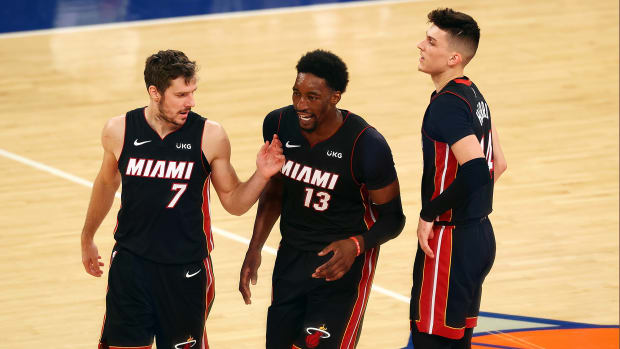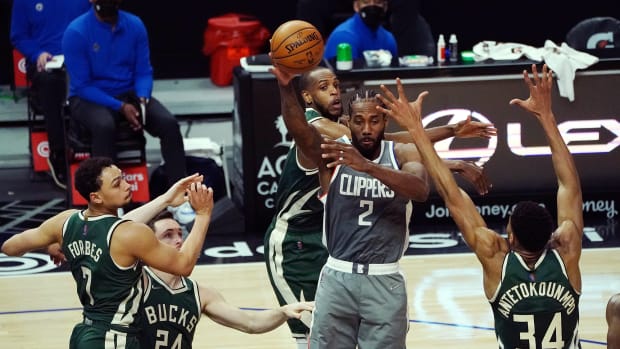Shrewd deadline moves rounded out the roster and made Miami a team no one wants to see in the playoffs.
Welcome to the Morning Shootaround, where every weekday you’ll get a fresh, topical column from one of SI.com’s NBA writers: Howard Beck on Mondays, Chris Mannix on Tuesdays, Michael Pina on Wednesdays, Chris Herring on Thursdays and Rohan Nadkarni on Fridays.
It’s been a rough season for the Miami Heat. They’re under .500, spinning their wheels in the Eastern Conference’s middle class one year after they were an eyelash away from winning the championship. Before they beat the Knicks on Monday night, the Heat found themselves skidding through a six-game losing streak, a drought they haven’t felt since 2017.
If you’re looking for reasons to believe this team can turn things around, some of Miami’s record-related problems can be explained by bad luck. They’re 13–14 in clutch situations. Bam Adebayo didn’t play in five of those games, Jimmy Butler missed seven of them, and Goran Dragić was sidelined for 16.
Some other stuff has been out of their control thanks to the weirdness that is rushing through an NBA season during a pandemic. Last year they had 15 starting lineups in the regular season and only three in the playoffs. This season, they’ve already spun through 21 starting fives in 47 games—change predicated on the need to experiment with a tweaked roster, navigate COVID-19 infections and precautionary measures, and physical issues that were likely spurred by an unprecedented offseason that was shorter for them than every other team in the league except the Lakers (another team, by the way, that’s had myriad significant injuries).
Six days after they pulled off a couple helpful deadline deals (not including the Trevor Ariza signing) that added Victor Oladipo without losing any real rotation players beyond Kelly Olynyk, the Heat head down the stretch with serious questions and frightening upside.
Most aspiring title contenders don’t have zero five-man lineups expected to appear in the playoffs that have logged at least 75 minutes this season. Can they stay healthy, solve some lingering holes that weren’t necessarily addressed at the deadline (like rebounding and center depth—though the former is somewhat a byproduct of all their switching and zone defense) and be willing to sacrifice as individuals—several key Heat players are playing for new contracts—for the sake of finding the best version of themselves before the playoffs begin? Incorporating new pieces isn’t easy, especially when the stakes are so high.
But, even with all the issues outlined above, what Miami has going for it is a range of high-level complementary talent that can adequately match up with just about any team in the NBA. In the playoffs, their roster yields a breadth of two-way options they can throw at the Bucks, Nets, Celtics, or Sixers (the four teams 538 currently lists as more likely to reach the Finals). There’s a chance Miami’s very best never manifests, but if its incoming pieces fit as well in real life as they do on paper, there’s no reason why this team can’t echo their bubble run.
Most cause for optimism starts at the top with Adebayo and Butler. Neither made the All-Star team after making it last year but their play makes that label feel like semantics. Both are more efficient and productive than they were last season. Adebayo is a foul-drawing monster, averaging 19 points, 10 rebounds, and five assists per game. Entering this season his career free-throw percentage was 71%. This season it’s 83.8%, which is 16th-highest in the league among all players who attempt at least five per game.
Without a three-point shot in his repertoire, Adebayo has still become one of the league’s more efficient scorers, a volcanic lob threat who, in a short offseason, somehow managed to stuff a consistent elbow pull up in his bag. Bam’s usage and assist rate are up, he’s turning the ball over less than the past two seasons, and in the playoffs his All-Defensive-team-caliber effort gives the Heat someone who can neutralize (relatively speaking) Kevin Durant, Ben Simmons, Giannis Antetokounmpo and any other threat who has the misfortune of catching him on a switch.
Then there’s Butler, another free-throw shooting force of nature who has suddenly emerged, at 31 years old, as a truly elite playmaker. Consider this stat: During his stay in Minnesota, Butler’s assist rate was 20.2%. Not too shabby for a wing. This season, he’s all the way up to 37.4%, eighth-best in the entire league.

As it relates to Miami’s season-long inconsistencies, this duo has only played 28 games together. They’ve also only combined to hit 15 threes all season. That’s not a huge issue when supported by a cast of top-shelf spacers, which they were last year, when the Heat finished second overall in three-point percentage (and first on non-corner tries). But right now only the Wizards, Cavs, and Rockets are less accurate behind the arc. No team is shooting worse off-the-bounce threes, either. Even Butler and Adebayo do share the floor, Miami’s offense isn’t even league average. These are the teams that are less efficient right now: the Cavaliers, Thunder, Timberwolves, Rockets and Magic.
Duncan Robinson still has plenty of gravity (and is one reason Miami is having so much success scoring at the basket), but he’s slid from 44.6% to 39.4% behind the arc. Tyler Herro is at 32.5%, down from the 39% he registered as a rookie. The jettisoned Olynyk had never shot the ball worse than this season, his eighth in the league, while last season he was just over 40%. Jae Crowder, who now plays for the Suns, set nets ablaze after Miami acquired him at last year’s trade deadline.
There’s no guarantee of a reversion back to what they shot from deep last season, but Nemanja Bjelica and Ariza (who’s 5-for-23 so far) should eventually help. Robinson is nobody to worry about and there’s a chance Herro settles in a bit now that the trade deadline has passed and he’s still in Miami. (Herro is at 43.5% since, and hit a season-high five threes on the day of.)
Watch the Heat and there’s a bubbling frustration that extends beyond how they shoot the ball, though. Sometimes they look drowsy in the half court, where quick decisions are a prerequisite for good shots. The ball sticks. On this play against the Blazers, look at how Erik Spoelstra reacts to Herro’s hesitation.
Execution is key. Timing needs to be crisp. When Spo isn’t happy with what he sees—in this case Kendrick Nunn apparently not knowing the play—his reactions can’t be contained.
Miami’s assist rate is still very high and it's averaging about the same number of passes per game. But there have been too many lineups that don’t have enough players willing/able to drive a closeout and create an advantage for a teammate or finish through traffic. They’re 7–11 without Dragić, who’s been in and out of the lineup all year.
Thanks to their top-10 defense—a turnover-forcing blur that blitzes pick-and-rolls, switches screens, doubles post-ups and generally makes offenses uncomfortable—and two legitimate stars, there’s a version of these Heat that can be awesome. The shot-making, length, versatility and collective IQ are all there for them to play spoiler for a round or two; if Butler, Adebayo, and Dragić are all healthy, playing together for at least 20 minutes every night (which is what they averaged during last year’s playoffs and is 12.5 more than they’re currently averaging) they’ll be an extremely difficult out.
But to be anything beyond a potential headache in the playoffs, Oladipo will need to execute Miami’s flexible defensive schemes while helping cure some of what ails the team on the other end. We haven’t seen him play a second in a Heat uniform, but a five-man unit made of Oladipo, Adebayo, Butler, Dragić and, say, Ariza, is nasty. What about Bjelica at the five, with Herro, Robinson, Iguodala and Nunn? Mix and match at your leisure. The number of competent-to-intriguing-to-devious possibilities is endless.
Oladipo can be the ultimate ceiling raiser without necessarily approaching the player he was three years ago. Miami doesn’t need him to be a primary or even secondary scorer. What they do need is another pick-and-roll playmaker, a one-man fastbreak and someone who can get downhill curling off a pindown, collapse the defense and spray the ball out to the perimeter.
In Miami, surrounded by more talent than he’s ever played with in his entire career, Oladipo’s True Shooting percentage will easily top the 50.8 mark it was at in Houston. And even though his pull-up threes haven’t fallen in three years, Oladipo is drilling 40% of his catch-and-shoot tries this season. If/when his role on offense is defined, in an environment where the ball pops, bodies whirl through space, and outside shots drop, the Heat will be a problem.
There are size issues that may need to be addressed in the buyout market. Not landing LaMarcus Aldridge, Andre Drummond or Gorgiu Dieng hurt. Damian Jones is out there. (So is DeMarcus Cousins!) But even if they enter the playoffs with Precious Achiuwa as their only big behind Bam, the beauty of this roster is that when something doesn’t appear to be working they can alter their rotation, adapt their style and reshape themselves in a way others can’t. So long as the Heat are healthy, counting them out of any series, at any time, won’t be wise.
LET'S NOT FORGET KAWHI

It feels like I could write an MVP column every week. The race is constantly changing, with shifting narratives influenced by hot streaks and unfortunate injuries. Heading into this season, it felt like voter fatigue would cancel Giannis Antetokounmpo’s candidacy before it could start. Now he’s a legitimate factor.
But what about the guy who beat Giannis’ Bucks on Monday night (without Paul George)? Kawhi Leonard is too quiet to ever make a case for himself, so allow me the honor. His team is third best by record in a ruthless conference, and according to Cleaning the Glass, the Clippers are 12.1 points per 100 possessions better when he’s on the floor—one of the best marks in the league.
During a season that will be remembered—at least on the court—for its explosive offense, Leonard leads the NBA in offensive rating. In minutes that don’t include garbage time, the Clippers’ offense scores 9.0 more points per 100 possessions than the Lakers have with LeBron James, and about five more than the Bucks and Giannis. Nikola Jokic and Damian Lillard are really the only two who come close here, but the Nuggets and Blazers are also significantly worse on defense when their franchise players play.
That’s not the case for Leonard, who’s still one of the fiercest defenders in the game while flirting with 50/40/90 splits, shooting an unconscious 77% at the rim. And, this might be wrong, but my mind goes here thanks to the level at which this year’s MVP debate has been influenced by what happened in last year’s playoffs: If Kawhi were having the exact same season he currently is, in a universe where the Clippers won the 2020 NBA title, he would be heavily involved in every MVP argument right now. Put some respect on his name.
More Morning Shootaround
Beck: Buyouts are warping the NBA's competitive landscape
Mannix: Clippers must make a deadline move
Nadkarni: The Nuggets have stumbled into their lineup of the future
Herring: Inside the NBA's year of the lefty
Pina: Dončić is finding his rhythm behind the three-point line

Post a Comment
Thanks For Comment We Will Get You Back Soon.